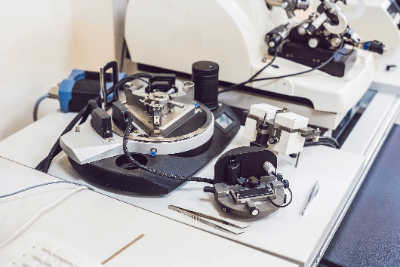What Is an AFM?
 AFMs (Atomic Force Microscopes) are microscopes that visualize the fine surface structure of samples by detecting and scanning the force between a probe called a cantilever and atoms on the sample surface. Unlike scanning tunneling microscopes, which are limited to conductive samples, AFMs can measure a broad range of materials, including insulators and biological samples.
AFMs (Atomic Force Microscopes) are microscopes that visualize the fine surface structure of samples by detecting and scanning the force between a probe called a cantilever and atoms on the sample surface. Unlike scanning tunneling microscopes, which are limited to conductive samples, AFMs can measure a broad range of materials, including insulators and biological samples.
Uses of AFMs
AFMs are primarily used in the industrial field for nanoscale to angstrom-level surface inspection. They are utilized for measuring the uniformity and roughness of semiconductor substrates, inspecting corrosion and degradation of plating on metal electrodes, and observing reactions and structural changes in biomolecules minimally invasively.
Key modes of AFM include:
- Contact mode: The standard measurement mode in AFM.
- Non-contact/dynamic mode: Uses cantilever vibration near its resonant frequency, where amplitude changes due to proximity to the sample are monitored.
Principle of AFMs
AFMs measure cantilever displacement caused by atomic forces between the cantilever and the sample surface. Common methods include using a photodiode for displacement detection (optical leverage method) and vibrating the cantilever with a piezoelectric element to monitor amplitude, phase, and frequency. Some AFMs measure the force directly by measuring cantilever flexure, useful for studying membrane proteins and cell mechanics.
What Can Be Learned by Using AFMs
AFMs can detect various forces like attraction, repulsion, adhesion, and binding. They are used in catalysis research and can observe minute particles on surfaces without special treatment. By modifying the tip, AFMs can function as chemical sensors, selectively measuring forces other than atomic forces.
Force Curve of The AFM
Force curves, measured by moving the tip in a reciprocating motion, reflect interaction forces between the tip and the material. These measurements can reveal van der Waals forces, surface tension-based adhesion, and meniscus forces. Force curve measurements have been applied to study the acid-base behavior of solid surfaces.
Difference Between The AFM and STM
An STM offers high atomic resolution in ultra-high vacuum environments but struggles with non-conductive materials and surface contamination. AFMs, on the other hand, can measure non-conductive materials and perform measurements in air, as they detect forces between the material and the tip.